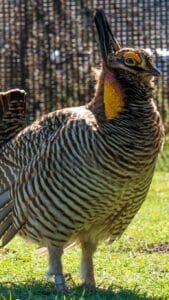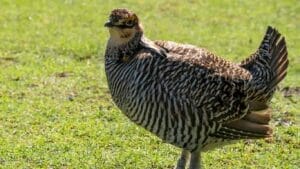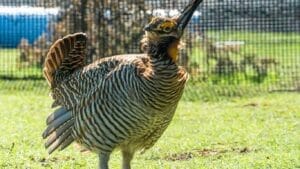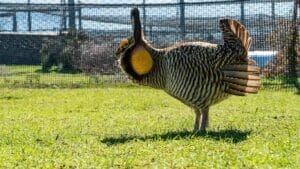
The Attwater’s prairie chicken is possibly the most endangered bird in North America. Even whooping cranes, a notoriously endangered waterfowl, have more wild numbers than prairie chickens. This is mainly due to the loss of their original coastal habitat and overhunting. Because of this, land conservation and rewilding efforts are all that stands between this species and extinction.
Appearance
Attwater’s prairie chickens are a small bird in the grouse family. Their feathers form vertical stripes in dark brown and dusty white over the majority of their body. This includes the male’s long pinnae, or elongated feathers that form ear-like structures. While females are unassuming, male Attwater’s are easily identifiable thanks to the bright, golden colored air sac on either side of their neck. This sac is inflated during their yearly mating season.
Adaptations
Attwater’s prairie chickens are native the coastal prairies of Texas and Louisiana. Because these prairies are sprawling grasslands broken up by small forests, they can vary in wetness depending on proximity to river deltas. Attwater’s prairie chickens are perfectly adapted to live amongst the tall grasses found along the coast. For instance, their striped pattern helps them blend in and hide from predators, and the climate of their habitat is perfect to produce their diverse food sources: grass roots, flower petals, seeds, and insects like grasshoppers.
Conservation
The Attwater’s prairie chicken once had a thriving population, but in the span of a little over 30 years, habitat loss reduced wild numbers from nearly one million to less than 9,000. By 2003, numbers were down to less than 50. Captive breeding programs have been created by facilities like Fossil Rim in an effort to rebuild the wild population to sustainable numbers, but the journey has not been easy.
These little birds are highly susceptible to changes in what little habitat they have remaining, so they often fall victim to various unavoidable natural disasters. In 2016 and 2017, flooding from spring rains and Hurricane Harvey destroyed an entire generation of Attwater’s eggs and drowned over 30 birds. After this, their wild population dwindled to only a little over 10 birds. While these numbers have since risen significantly, there is still a lot of work to be done to protect this unique species. In 2024, they became part of a Saving Animals From Extinction (S.A.F.E.) program, which will help concentrate conservation efforts.
Where are they?
One Attwater's Prairie Chicken lives at Animal Discoveries, while the rest live in our Intensive Management Area. They blend in well with their surroundings, so make sure to look close!
VIEWING TIPS
If you are not able to see the adult APCs on your guided tour or at Animal Discoveries, be sure to listen for the males. In the spring and summer, you might hear them booming when you are near the APC facility.
Quick Facts
Scientific Name | Tympanuchus cupido attwateri |
Species Survival Plan | No |
Habitat | Coastal prairie |
Food | Grasses, flowers, seeds and insects |
Originally Native To | Texas and Louisiana |
Characteristics | Brown grouse with striped pattern on feathers; male has large yellow air sac on neck |
Size | around 2 lbs. |
Birth Season | May - June |
Lifespan | Wild 2 - 3 years |
Social Behavior | Hens with chicks; solitary |






